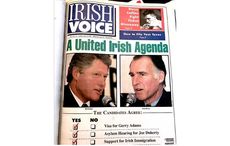The headline was not exactly subtle. “Mayor de Blasio Defends Appointing Yet Another White, Irish NYPD Commissioner.”
It was The New York Observer’s online edition. Given the racial conflict that has emerged on the streets of New York, and the day-to-day tension that exists between many white police officers and the diverse citizens they are charged with protecting, many believe it would have made a lot of sense to appoint a black or Hispanic top cop.
Still, let’s not deny that James P. “Jimmy” O’Neill is a great New York character. Let’s not make it seem like this is some rich kid from the suburbs who found a calling in law enforcement and bullied his way to the top.
O’Neill grew up one of seven siblings in an Irish American family in East Flatbush, Brooklyn. Once heavily Irish, that area has undergone intense change in recent years.
Many families like the O’Neills left for other traditionally Irish Brooklyn neighborhoods like Bay Ridge, Marine Park or Gerritsen Beach. Others still moved further out to Staten Island or Long Island or New Jersey.
Read more: New York Irish American Police Commissioner sworn in as bombing suspect arrested
Given that, it seems as if some people want to write the Irish out of the New York story entirely. Not everyone. Some people make a fine living off of the old-timey nostalgia that fuels desires to rebuild Ebbets Field right there at Bedford Avenue and Sullivan Place.
And yet there are others -- to begin with, the folks who read and write headlines for publications like The New York Observer -- who would make it seem like the appointment of “yet another” Irish American as top cop is some kind of event out of the 1890s.
Make no mistake about it: Brooklyn -- and New York -- continue to change radically. Just last week, new statistics release by the U.S. Census bureau’s American Community Survey (ACS) showed that Brooklyn experienced that greatest population increase among the five boroughs.
And it wasn’t all just aspiring hipsters from Iowa. Brooklyn also had the largest number of immigrants move there, according to the ACS, with the Bronx coming in second.
And yet, for all of these changes, what never ceases to amaze me is the degree to which the Irish remain central to the fabric of New York. Hence, a new commish from East Flatbush.
In fact, the Brooklyn Irish are having something of a moment. This month, Kathleen Donohoe’s compelling novel Ashes of Fiery Weather was released. The book looks a several generations of firefighters and their families who settled in a Brooklyn very much like the one Jimmy O’Neill grew up in.
And yes, the book does spiral back in time to the 1800s, when some of the book’s characters came to Brooklyn from Ireland. But one of Donohoe’s many accomplishments in this excellent book is that she brings these Brooklyn Irish firefighters -- male and female, by the way -- into the 21st century.
Also this month, we get Exile on Bridge Street from Brooklyn novelist Eamon Loingsigh. The book, a follow-up to his previous gripping novel The Light of the Diddicoy, is set on the rough-and-tumble streets in the shadow of the Manhattan Bridge, where Irish and Italian immigrants fight fiercely for control of the docks and all the jobs and money that comes with that control.
At the center of the struggle is Irish immigrant Liam McGarrity, who has trouble on both of the Atlantic. Back in Ireland, his family is caught up in the whirlwind of the Easter Rising.
On the surface, Loingsigh’s book mines Brooklyn’s gory and glorious Irish past. But it is also the quintessential read for 21st century Brooklyn.
Not only is it all too plausible that Liam McGarrity’s grandchildren are cops of firefighters living in Marine Park. But consider all of those immigrants coming into Brooklyn these days.
Love? Death? Money? Struggles in the homeland?
Surely they can relate to a thing or two Liam had to endure as he was becoming an American in Brooklyn.




Comments